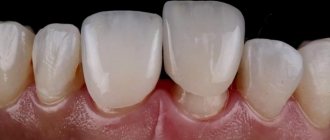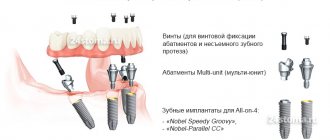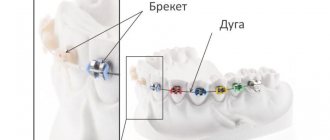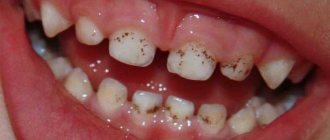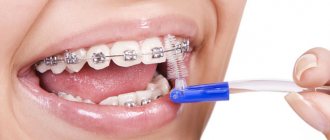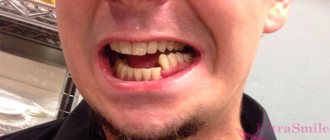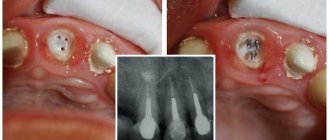Content
- What are the dangers of improper crown care?
- What to do after installing crowns
- When to see a doctor
Crowns are the most popular method of restoring damaged and lost teeth. Following the rules of care will help keep your teeth beautiful and healthy after dentures. Despite the fact that the tooth is artificial, plaque continues to accumulate on it. Also, do not forget that there are neighboring living teeth and soft tissues that may be damaged due to careless handling.
PROMOTION
Installation of crowns, dental bridge
RUB 3,450
How long will different types of crowns last, and what determines their “life”?
To have an idea of how often crowns need to be replaced, you should learn about the service life of various orthopedic structures. So let's look at this aspect from the perspective of different ways of classification.
For example, according to the period of wearing, temporary and permanent ones are distinguished. Temporary ones (made of composite or acrylic) last a very short time - from several days to 3-12 months. Permanent ones can last an average of 5-7 years. After how many years crowns are replaced depends on their service life, materials, manufacturing features, and how properly a person cares for them.
If we consider materials, then ceramic and metal-ceramic products will last up to 10 years maximum - with very good care. Zirconium dioxide or those made from lithium disilicate last longer - from 15 years. The manufacturing method is also important here - for example, zirconium dioxide structures milled with special devices can last more than 25 years. And ceramics processed using the classical method (manually) lasts about 7 years.
What are the dangers of improper care after prosthetics?
Bad breath and visible plaque are only superficial manifestations of poor hygiene. In fact, the consequences are much more serious:
- Plaque, accumulating near the surface of the gums, contributes to the formation of tartar.
- Tartar, in turn, is a breeding ground for bacteria.
- The waste products of harmful microorganisms have a destructive effect on the natural tissues of teeth and soft tissues, and provoke inflammation of the gums.
- When the gum becomes inflamed, its structure becomes loose. Such gums are not able to protect the cervical area of the teeth.
- If left untreated, seemingly harmless inflammation of the gums leads to much more serious consequences - periodontitis, the formation of gum pockets.
Simply put, dental hygiene and oral health are inextricably linked.
Stage 1. Preparatory stage of treatment of a cyst of the tooth on which the old crown stood
A common problem when replacing old crowns is the destruction of the supporting teeth under the crowns. This is explained by the fact that crowns are worn for too long and the teeth under the crowns begin to deteriorate and caries develops.
This was the case in the presented case. After removing 4 crowns, the teeth were severely damaged. On one tooth there was a large cyst, granuloma, and inflammatory process on the root.
The patient felt very sorry for his tooth, and he asked to save it if possible.
Treatment of granuloma delayed the stage of prosthetics by 1.5 months. But in the end, the patient’s tooth was saved.
Rules of conduct after installing crowns
There are several rules that you can follow to keep your mouth healthy:
- Brush your teeth twice a day – immediately after waking up and before going to bed.
- Rinse your mouth if possible after every meal. This will get rid of food debris and slow down plaque formation.
- Thoroughly clean areas where plaque and food may accumulate. We are talking about the space under the hinged crown of the bridge. To do this, you can use an irrigator, brushes and other devices.
- You should avoid eating too hard foods and chewing on non-food items. Nail chewing, nuts, candy chewing – all of these should be avoided to maximize the life of your crowns.
- You should reduce your consumption of coffee, black tea, red wine, and other coloring foods.
- Gum care is also a very important attribute of healthy teeth. Rinsing and careful attention to the condition of soft tissues are required.
- Cleaning your tongue is a very useful activity. Plaque also accumulates here and must be removed.
Careful care will help maintain health and maximize the service life of any restorations.
Caring for ceramic crowns and veneers
Ceramic crowns and veneers are orthopedic structures that restore lost tooth tissue or eliminate dental discoloration (discoloration, usually in the anterior section). These structures can be installed in the area of the lateral teeth and are in the form of crowns or inlays, as well as in the area of the front teeth and can be in the form of crowns and veneers (thin overlays that are fixed to the outer surface of the teeth). They are made from various types of ceramics: feldspathic ceramics, glass ceramics, oxide ceramics.
And today there is a misconception that if you have ceramic crowns installed, you can forget about them. Not really! On the contrary, the success of treatment and prosthetics, as well as the service life of restorations, are determined by careful care both at home and in the dental clinic.
Ceramic restorations have an area of contact with tooth tissue in the subgingival region, and in this space between the gum and restoration, as well as on the surface of the crown or veneer itself, plaque can accumulate, which can lead to negative consequences.
Dental plaque is formed in the form of a biofilm - a heterogeneous bacterial mass that is organized as a solid structure (has an extracellular matrix, due to which it is tightly attached to the teeth and to orthopedic structures), which can only be removed mechanically. This biofilm leads to soft tissue inflammation, which disrupts the adherence of the gum to the surface of the restoration and contributes to the formation of subgingival dental plaque, which can disrupt the marginal fit and tightness of the crown/veneer and cause a carious process in the area of the tooth root, lead to gum recession, as well as changes in the color of the restoration, and in advanced cases, its loss.
This is what inflammation of the gums (gingivitis) looks like in the area of ceramic restorations
In this photo you can see soft plaque in the gingival area of the ceramic restoration and inflammation of the gums.
What should you not do after installing veneers?
- It is not recommended to chew nuts, crackers, seeds, etc., and you also need to get rid of the bad habit of gnawing on objects (pens, pencils...), since these products can lead to microcracks with constant exposure, and subsequently to chipped restorations;
- It is not recommended to use highly abrasive pastes on a regular basis, as they can scratch the surface of the ceramic;
- consuming foods that lead to a sharp change in temperature, for example, drinking hot tea after ice cream, this can lead to cracks.
What should you do after installing veneers?
- carry out careful care at home;
- regularly carry out professional dental hygiene procedures;
- regularly visit the dentist for preventive examinations;
- If a crack or chip occurs, consult your doctor immediately;
- follow all recommendations;
- if you engage in extreme sports where there is a risk of injury, it is recommended to use special protective mouth guards;
- If you have bruxism (teeth grinding), it is also necessary to use protective mouth guards.
How to whiten veneers?
This question comes up often. Let's see in what cases veneers can change color?
Ceramics itself does not change color. If the seal of the restoration is compromised, food coloring may be absorbed in this area and the border of the restoration will be stained. In this case, the restoration will most likely need to be replaced. Or, if hygienic care is not observed, plaque becomes fixed on the surface of the restoration, which can become stained and change the color of the veneers. In this situation, professional hygiene, selection of personal hygiene products and training in the correct technique for brushing teeth are necessary.
Professional hygiene of ceramic crowns and veneers
As mentioned earlier, regular professional hygiene is one of the most important criteria for the success of the treatment. This procedure is recommended to be carried out every 3-6 months based on the individual clinical situation and home hygiene skills.
How is professional hygiene of ceramic restorations carried out?
- At the first stage, the hygienist examines and assesses the hygienic status of the oral cavity.
- Then the procedure itself is carried out using gentle techniques (special hand tools, AirFlow using powders based on glycine and erythritol, superflosses, polishing strips, brushes and rubber bands with polishing pastes).
- The next step is to help the doctor select personal hygiene products and adjust home care.
How to properly brush teeth with veneers?
- Teeth should be brushed at least 2 times a day using soft-bristled toothbrushes;
- After each meal, use toothpaste or mouthwash;
- use additional means such as dental floss, superfloss, dental brushes (they will help MECHANICALLY clean hard-to-reach places, which is necessary to remove biofilm - dental plaque);
- use an irrigator.
What toothpastes should I use to care for ceramic crowns and veneers?
As already mentioned, highly abrasive pastes are not recommended for use, and they are not necessary for regular and proper maintenance.
It would be optimal to use pastes with complex action, based on enzymes, pastes with xylitol; they can be alternated with pastes based on herbal ingredients to care for the gums and maintain their health.
Prosthetics with ceramic crowns and veneers is an expensive and quite labor-intensive process. Therefore, it is very important to follow all recommendations and carry out careful hygienic care. This will allow you to avoid complications and enjoy a beautiful and healthy smile for a long time!
How to know when it’s time to change your denture - symptoms
You can determine when the crown on a tooth needs to be replaced by the following symptoms, signs or manifestations:
- the prosthesis is wobbly
- the prosthesis has fallen out: under no circumstances should you put it back in place yourself - it is better to rinse it, wrap it in a sterile bandage and consult a dentist as soon as possible,
- the gums become red, swollen or begin to bleed,
- there is a metallic or sour taste in the mouth, there may be a tingling sensation due to galvanism,
- a tooth or area of the jaw hurts: the pain appears with pressure or does not depend on irritants,
- the prosthesis is damaged: there are chips or cracks,
- Closing the jaws causes discomfort.
Of course, the need for replacement is determined only by an orthopedic dentist. If the structure is held fairly tightly in place, then an X-ray examination is performed to diagnose or exclude complications - cracks, cysts, bone atrophy, caries, and to assess the quality of the previous obturation of the root canals.
Is it possible to remove the crown yourself and what should you do if the crown falls out at home?
In emergency cases, you have to make a decision without the participation of a doctor. If you are far from civilization and cannot immediately go to the dentist, then the fallen crown must be carefully wrapped in a napkin and packed in a plastic bag. A fallen denture does not protect the ground tooth stump, so you need to be extremely careful when eating. If pain occurs, which is not uncommon in this case, you can relieve the pain with any oral anesthetic that suits you. But the main thing is to get to the doctor as soon as possible, taking the destroyed crown with you.
It is absolutely impossible to delay the process, because the stump on which the prosthesis was based may collapse, and then there will be nothing to attach the new crown to. This means that the root will have to be removed and the issue resolved through bridge prosthetics or implantation, which is much more expensive than making a new crown.
In order for the crown to serve for a long time, it is necessary to re-cement the prosthesis once every 5-6 years, because The service life of dental cement is just 5-6 years, then slowly, under the influence of the acidic environment in the oral cavity, it begins to gradually wash out and its place is “taken” by the wrong microflora, which leads to the destruction of the tooth on which the crown is placed.
Important! If you re-cement the crown every 5-6 years, it will last a lifetime!
